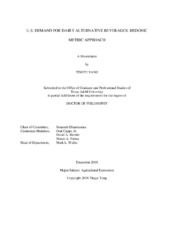| dc.contributor.advisor | Dharmasena, Senarath | |
| dc.creator | Yang, Tingyi | |
| dc.date.accessioned | 2019-01-23T21:57:40Z | |
| dc.date.available | 2020-12-01T07:33:35Z | |
| dc.date.created | 2018-12 | |
| dc.date.issued | 2018-11-29 | |
| dc.date.submitted | December 2018 | |
| dc.identifier.uri | https://hdl.handle.net/1969.1/174619 | |
| dc.description.abstract | The consumption of dairy alternative beverages in the United States has increased rapidly in recent years. Conventional milk seems to be losing its market share to dairy alternative beverages, such as almond and soy milk, mainly because of the taste, health concerns and environmental concerns with these beverages. It is expected that the ongoing competition between conventional milk and dairy alternative beverages will continue to intensify over the next several years.
This work is motivated by the need to take into consideration of intrinsic characteristics and difference of such characteristics when measuring the differentiation of products in demand estimation. Hedonic pricing model is extended by constructing a hedonic matrix for a variety of qualitative attributes of three dairy alternative beverages and four conventional milk categories to model consumer demand for these products in the United States. A two-stage estimation procedure is applied. The first stage is to create a multi-dimensional hedonic space based on the qualitative information available to consumers. The next stage is to allocate the different types of conventional milk and dairy alternative beverages considered in this study into the space and estimate the demand elasticities using attribute distances. Our methodology is advantageous in that it not only solves the price endogeneity problem typically questioned in demand systems estimation but also remarkably reduces the number of parameters estimated. Therefore, it enables a large number of differentiated products to be considered in a demand system.
Nielsen Homescan consumer panel data 2004-2015 is used in this study. The final data set is aggregated to UPC level of products which captures not only enough variation in nutritional variables but also consumer purchase information.
Results show that soy milk has the highest own-price elasticity which is -0.2506. Inelastic demand of all three types of dairy alternative beverages reflects that they are not sensitive to price changes. Soy milk is found to be a substitute for all four types of conventional milk products and vise-versa. Three dairy alternative beverages are complements between each other and four types of conventional milk are substitutes between each other. | en |
| dc.format.mimetype | application/pdf | |
| dc.language.iso | en | |
| dc.subject | Dairy Alternative Beverages | en |
| dc.subject | Barten Synthetic Model | en |
| dc.subject | Hedonic Matric Approach | en |
| dc.title | U.S Demand for Dairy Alternative Beverages: Hedonic Metric Approach | en |
| dc.type | Thesis | en |
| thesis.degree.department | Agricultural Economics | en |
| thesis.degree.discipline | Agricultural Economics | en |
| thesis.degree.grantor | Texas A & M University | en |
| thesis.degree.name | Doctor of Philosophy | en |
| thesis.degree.level | Doctoral | en |
| dc.contributor.committeeMember | Capps, Jr., Oral | |
| dc.contributor.committeeMember | Bessler, David A. | |
| dc.contributor.committeeMember | Palma, Marco A. | |
| dc.type.material | text | en |
| dc.date.updated | 2019-01-23T21:57:40Z | |
| local.embargo.terms | 2020-12-01 | |
| local.etdauthor.orcid | 0000-0001-5830-5761 | |


